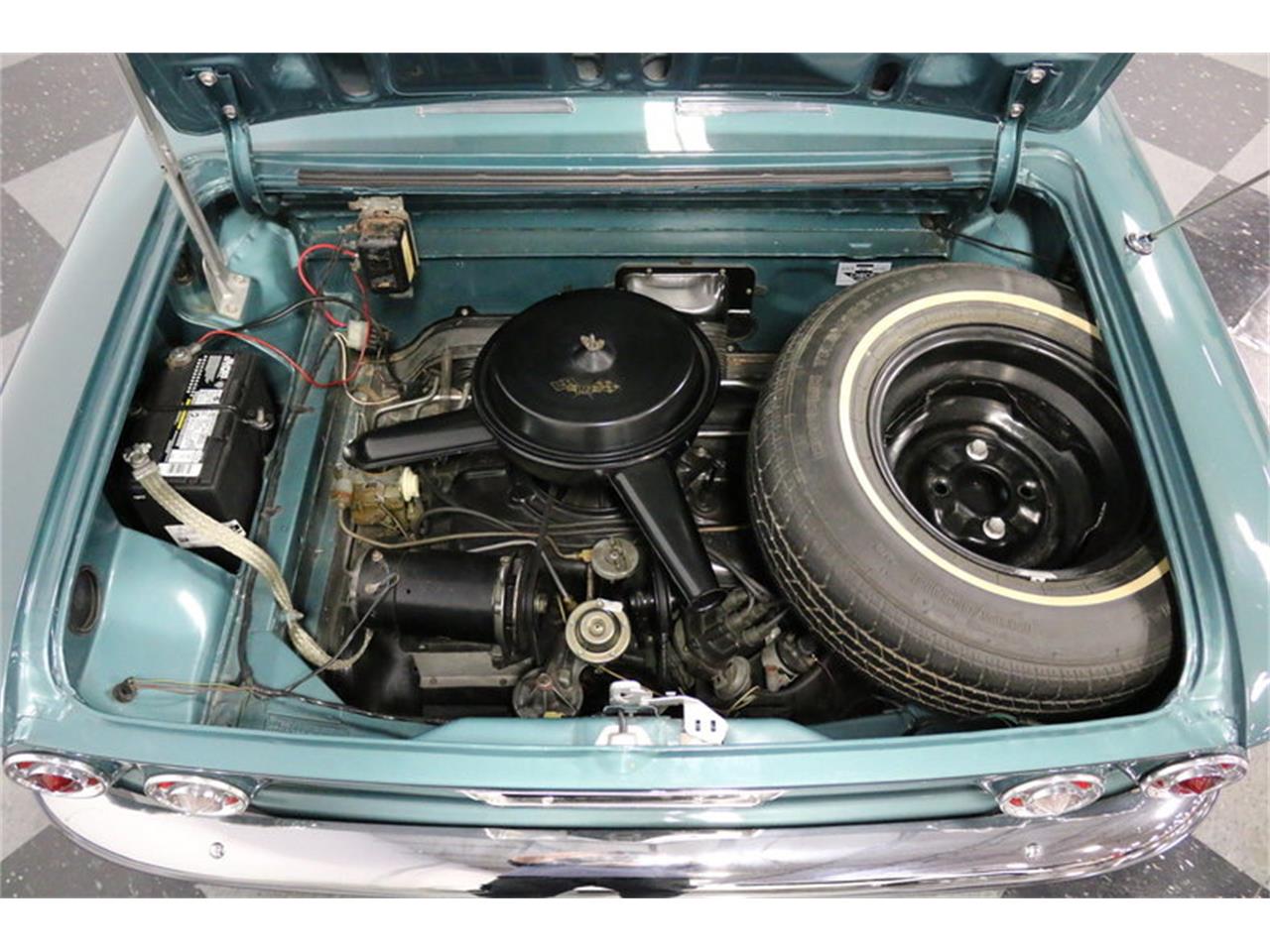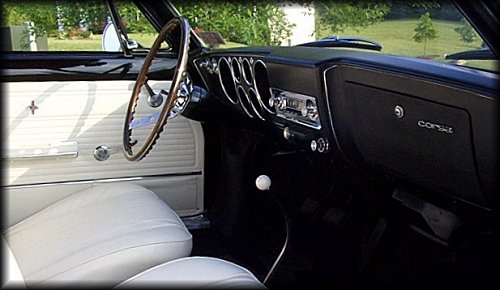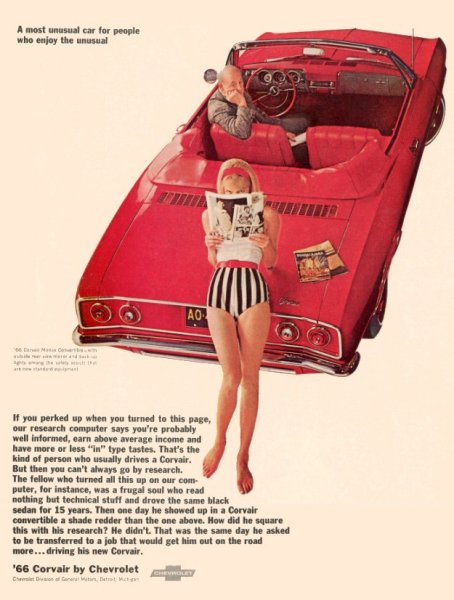would like info
would like info
HI GUYS. I don't own one yet but am kicking around the idea of restoring one this summer or at least get one up and running and do the fine tuning as I go. There are horrors and successes in any rebuild and I would like to minimize the prior. Question: what is a good model with some thing I can get a little HP out of. I drive a CRX now and love the sporty scooting around but I would like a little more GUG. The CRX will be gone to fuel the corvair build. Any input would be welcome and maybe I can share as The progress comes along IF I decide to take on a project.
- bbodie52
- Corvair of the Month

- Posts: 11956
- Joined: Mon Aug 06, 2012 12:33 pm
- Location: Lake Chatuge Hayesville, NC
- Contact:
Re: would like info
I wrote the following material some years ago, and after considering your initial comments I feel that this information about Corvairs may be helpful to a new owner who has little experience with DIY maintenance or ownership of a classic Corvair.
My own experience with Corvairs began in 1961, when I was eight years old. We lived in San Jose, California at that time. My parents bought a new 1961 Corvair Monza coupe, and that was our family car for several years. In 1965 they traded up to a new 1965 Corvair Corsa convertible, with the same 140hp 4-carburetor engine that your Corvair is fitted with (four speed manual transmission).
Warren Bodie and son Brad at Edwards AFB Air Show in 1965 with our new 1965 Corvair Corsa convertible (140HP)
I learned to drive in that Corsa convertible, and began to learn how to maintain Corvairs by performing basic tasks on it, like oil changes, tune-ups, tire rotations, etc. I took my first driver's license test in that car, and during my high school summer vacation in 1969 my father purchased a baseline 1963 Corvair 500 coupe with a frozen engine and a Powerglide automatic transmission for me to learn on. He provided a garage to work in, funding support, an ample supply of hand tools, jack stands, shop manuals, etc. and I taught myself to remove the powertrain and disassembled/overhauled the engine successfully (only taking a break from the work involved to go into the house and watch Neil Armstrong walk on the Moon). After discovering that the automatic transmission was also faulty, I disassembled the transmission and rebuilt it successfully too. There were no local Corvair clubs, and no Internet or Corvair Forum was available at that time to guide me, but I took the time to learn by doing and following the shop manual procedures, and that knowledge helped to build my self-confidence and to develop some mechanical skills that continue to support me to this day!
bbodie52 wrote:There is much to consider, and the material below is something I wrote some years ago to try to help the first-time Corvair buyer. I hope you will find these comments to be useful...
As a teen and beginner, I gained some basic knowledge and understanding from a stack of Petersen's Publications books I had collected, read, and reread. (This series was published long ago (1960s-1970s) by Petersen Publishing Company, which was also associated with Hot Rod Magazine. With titles like Petersen's Basic Cams, Valves and Exhaust Systems, Petersen's Basic Ignition and Electrical Systems, and Petersen's Basic Carburetion and Fuel Systems, I found the knowledge and explanations they contained to be very helpful. Internet research opportunities were far in the future, so old-fashioned books and the Corvair Shop Manual were my only guide.
https://www.amazon.com/s?k=Hot+rod+maga ... nb_sb_noss
ebayhttps://www.ebay.com/sch/i.html?_odkw=b ... c&_sacat=0
The material in those books is now somewhat dated because of the change to computer-controlled electronic fuel injection and other sophisticated technologies that have been introduced in the subsequent decades. But I do feel a Corvair owner or any classic car owner could benefit from the material in these books. Many of them are listed as available on Amazon.com (and from other sources like eBay). You might consider the possibility of reading through some of this material, the above links may help you to find them. The cost of these used books is low, and the investment in time that you might make in reading them may help you to develop a foundation of knowledge that will help you to leap ahead in your DIY maintenance efforts on your Corvair.
The Corvairs are vintage 1960s technology and design — easy to learn and easy to maintain. I would say that learning to work on a Corvair is analogous to an experienced home DIY "shade tree" car mechanic learning to work on a motorcycle. The concepts and procedures are very similar, but the details and the way it is put together is a little different. With the Corvair engine (like a motorcycle) you are dealing with a lot of aluminum. The metal is soft when compared to steel and cast iron, so the use of a torque wrench, anti-seize compound and carefully avoiding cross-threading becomes more important. Also, (like some motorcycles) you are dealing with multiple carburetors so tuning procedures are a little different. The use of Corvair shop manuals and supplements, other technical guides, and information sources like the Corvair Forum, and perhaps joining a CORSA (Corvair Society of America) club chapter can help you to quickly learn about Corvairs. Information resources, like good Corvair parts suppliers, are plentiful if you know where to look. Suppliers like Clark's Corvair Parts have been well-respected and extremely supportive since 1973, and suppliers like that make Corvair ownership more practical and much-more possible. I taught myself how to remove a Corvair powertrain, overhaul the engine, and rebuild the Powerglide transmission during my summer vacation in 1969, when I was sixteen years old. I was working alone (my father had been transferred by Lockheed from northern California to southern California, and we had not yet moved to join him). I had a shop manual and a garage full of tools. There was no Internet, no Corvair Forum, no CORSA club — I was pretty-much on my own. Yet I learned and was successful (in 1972 that engine carried me and my new bride on our wedding day and on our honeymoon).
So you should be able to master working on Corvairs without too much trouble — except watch out for rust and body rot! The Corvair is of unibody construction, so most body repair involves cutting and welding. The doors, trunk lid (in the front), and engine compartment lid (in the back)
and maybe the gas filler door are the only bolt-on body components. Everything else is cut and weld, and the body serves as the main chassis frame. So unless you are a master body repair technician, you need to select your Corvair carefully and avoid excessive hidden rust or a "Bondo bucket". The door frame areas, fenders, floor pan, the bottom of the trunk, lower windshield and battery area often rust and rot.
What follows is an attempt at introducing new prospective Corvair Owners to Corvairs and some of the issues involved. Food for thought, before you take the plunge. This is a copy of something I wrote earlier, but I think it may be helpful in your quest for the "right" Corvair...
bbodie52 wrote:I will try to provide a quick summary of the 1960-1969 Corvair lineup, and will also try to provide some answers regarding the use of a Corvair as a "daily driver".
EARLY MODEL: 1960 - 1964 Corvairs were the first generation. Their body style emulated other Chevrolet body styles from the early 1960s. The rear suspension was a swing-axle design that was similar to the Volkswagen "Beetle". The 1960 model year was the only year with a 140 cubic inch engine, and there were some characteristics that were unique to that model year only. A number of refinements were implemented in the following year, including some restyling of the front end and an increase in displacement to 145 cubic inches (CI). A manual choke was used in 1961, and this was changed to an automatic choke design in 1962 that remained with the car through 1969. A turbocharged 150 hp Spyder was introduced in 1962, and the Spyder name remained with the turbocharged engine through 1964. In 1964 the engine displacement in all Corvair engines increased from 145 CI to 164 CI. There were also some suspension refinements, including a front anti-sway bar and a rear transverse leaf spring to improve handling in all 1964 Corvairs. Here are a few pictures of Early Model (EM) 1960-1964 Corvairs...
1964 Monza Convertible
1964 Corvair Engine Compartment
1963 Monza Coupe
1963 Monza Interior
1962 Lakewood Station Wagon
Corvair Rampside Truck
Corvair Greenbrier Van
Van/Truck Interior
LATE MODEL:The 1965 Corvair introduced a completely new body style, that was also seen later in similar styles in the Camaro and Pontiac Firebird. The drum brake size was increased, and the swing-axle rear suspension design used in EM Corvairs was abandoned. The new rear suspension was a design lifted from the Corvette Stingray.
1965 and 1966 Corvairs were nearly identical. In 1967-69 the top of the line Corsa was dropped, leaving the Monza and economy 500 until production was discontinued in the spring of 1969. During the 1967-69 production period, there were minor safety changes, such as a dual master brake cylinder in place of the single unit used in 1960-1966. Interior seats and trim changed somewhat, paralleling the items used in Camaros and some other GM products during that period.
All 1965-66 Corsas came with a standard 4-carburetor 140 hp engine, and an optional 180 hp turbocharged engine. The 140 hp engine remained optional in the rest of the lineup. Other engine options in the Monza and 500 were 110 hp and 95 hp dual carburetor engines. All engines could be had with a manual 4-speed or 3-speed transmission, or with a 2-speed Powerglide automatic (with the exception of the 1965-66 turbocharged 180 hp engine, which was available with the Corsa only, and only with a 4-speed manual transmission).
Air conditioning was a rare option, but can be found in the 1965-1967 lineup, and some of the EM Corvairs as well. The following link will provide you with some air conditioned Corvair background and history...
http://www.corvair.org/chapters/airvairs/
The brakes, front and rear suspension, transaxle and body were essentially identical in the Corsa, Monza, and 500. The primary differences in the cars were the instrument panel (the Corsa had more gauges), trim details, and the engine option.
The late model Corvairs were available in a 2-door Coupe, 2-door Convertible, and 4-door Sedan. In 1968, the four-door hardtop was discontinued, leaving three models—the 500 and Monza Hardtop Coupes and the Monza Convertible. Air conditioning was dropped as an option. The weight of the cars was very similar in all configurations.
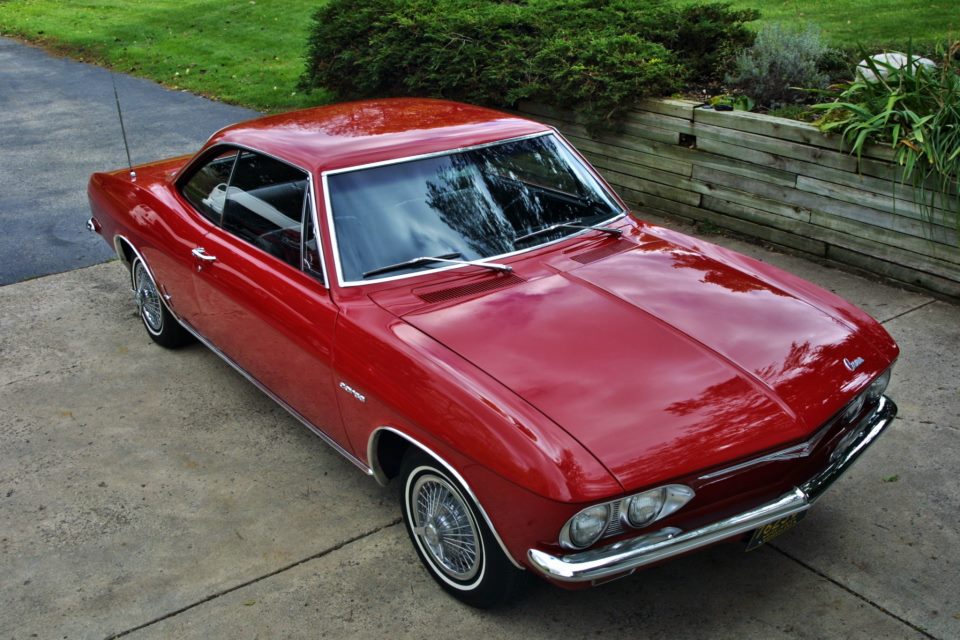
1965 Corvair Corsa Coupe

1965 Corvair Corsa Convertible
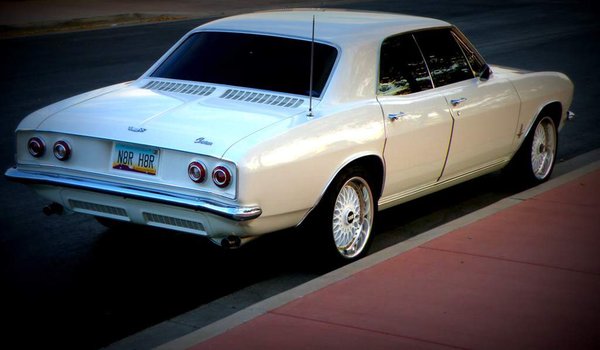
1965 Corvair Monza 4-Door Sedan
Corsa Interior (Top) / Monza Interior (Bottom)
140 hp 164 CI 4x1 Carburetor Engine (1965-1969)
Corvairs can suffer from rust and body rot problems, especially in areas that use a lot of road salt in the wintertime. While you may be able to learn and successfully attack most mechanical issues as a DIY effort, body decay can be much-more difficult, time-consuming, intimidating, and expensive to correct. So look for hidden rust or rot problems that may have been covered up with plastic filler, and be cautious in your Corvair selection.
A Corvair can serve well as a daily driver. But I would recommend a backup car or other alternatives, since ANY breakdown can put the car out of service for days until replacement parts can be obtained (if needed). If you have the skills and ability to work on the car yourself, repairs can often be completed fairly quickly. But if you have to rely on professional mechanics, downtime can be long and possibly expensive — if you can find a good mechanic to do the work for you.A Corvair can serve well as a daily driver. But I would recommend a backup car or other alternatives, since ANY breakdown can put the car out of service for days until replacement parts can be obtained (if needed). If you have the skills and ability to work on the car yourself, repairs can often be completed fairly quickly. But if you have to rely on professional mechanics, downtime can be long and possibly expensive — if you can find a good mechanic to do the work for you.bbodie52 wrote:Here is something I wrote over a year ago — Brad's Admonition, or some words of advice — based on over 50 years of exposure to Corvair ownership — that I wrote to try to give new Corvair buyers some idea of the issues involved. I'm sure you have some idea already, but I also think this is worth considering...
Since you are new to Corvairs, I want to give you some information that I have written to other new prospective first-time Corvair owners. I have been involved with Corvairs since I was eight years old, when my parents bought our first Corvair – a brand new 1961 Monza 2-door coupe, white on red with a 4-speed transmission. I now own Corvair number ten, which I purchased in June 2012. (If you want to read a brief personal biography that outlines my family background and our experiences with Corvairs, go to CORVAIR FORUM > Introductions > New from Lake Chatuge North Carolina. viewtopic.php?f=13&t=4032 ) I want to encourage your enthusiasm in developing your plans to buy your first Corvair, but at the same time I want to help you to think through just what you are getting into. So please read and consider these comments below...
I have listened to many potential Corvair first-time owners. Many have no prior experience with owning any classic car, and many have never driven a Corvair at all, or have not driven one in decades. Some are motivated by childhood memories of a family Corvair. They typically describe the desire to locate a perfect, restored, ultra-clean example, and look to the Corvair Forum Corvair enthusiasts and aficionados to tell them what to do.
The first thing I think that needs to be done is to try to set-aside the usual emotion-based enthusiasm that any car buyer might feel when visiting a dealer and gazing with emotional eagerness at the vast array of new cars displayed in the showroom, on the car lot, and in factory brochures and advertisements. There is an extreme difference between owning a 50+ year-old Chevrolet that was likely engineered, designed and built with pre-planned obsolescence in mind — a car that GM only envisioned having a life-span of ten years or so. Many of the potential Corvair buyers are captivated with the exciting idea of owning something different — something not normally seen on the road — something that your neighbor will not buy! Certainly that is the case with a Corvair, but owning a Corvair and enjoying that ownership demands a certain dose of reality before you "buy-in". Many are unprepared for the maintenance and upkeep demands of a Corvair. "Where can I find a good Corvair mechanic?" is a common question — often displaying an inability or unwillingness to do some mechanical work and maintain that car yourself. Yet qualified Corvair mechanics can be distant, expensive, inconvenient, and all-too rare. At a time when finding even a spark plug, fan belt, or oil filter for a Corvair often means an Internet or mail-order purchase, finding local support may be unlikely or impossible. Even searching automobile junk yards will often not help, because these cars are so rare and infrequently found that they have all but disappeared from the scrap yards too. Even locating and buying a used part is a mail-order proposition. And even if you spend $15,000-$20,000 for a fully-restored Corvair in mint condition, it still comes "as-is", with no warranty and little in the way of a local support system — far different than what most car buyers are used to expecting! These are the realities of owning an older classic car.
Corvairs are popular and affordable classic cars, and enjoy a good infrastructure of maintenance supporters, owner's clubs, and parts suppliers — and that REALLY helps! But I suspect that most happy Corvair owners are something of "shade-tree mechanics" and hobbyists who are prepared to deal with the risks and problems related to Corvair ownership. It requires a long-term commitment and a dose of reality to happily own a classic Corvair. The "first date" infatuation with the attractiveness and uniqueness of a Corvair will not sustain you in a long-term relationship with a Corvair. It is far-better to have a realistic idea of just what you are getting into before you "take the plunge" and buy your dream car.
A cautious, knowledgeable and educated search for your dream Corvair is a great start, and a careful and realistic analysis of your own mechanical talents, skills and abilities is also useful. If you plan to have a mechanic do most of the work for you, the availability of a Corvair-skilled mechanic and the associated costs involved must be taken into account in your financial planning to own a Corvair.
I try to not be too negative, but I have worked with others who came to realize that Corvair ownership was more than they could handle. I just feel that new prospective Corvair owners come here to this forum to learn from others who have more experience, and we are not doing them any favors by "candy coating" the issues involved. If they pass the "sanity check" and still want to pursue buying a Corvair, then GREAT! This Forum and perhaps some local Corvair club members can potentially help them pursue that dream. But it should be a realistic dream, and not a frustrating "nightmare" experience. Better to make a clear-headed, informed decision early in the game!
I hope that these comments are useful to you. I know I get "long-winded", but I also know you are trying to make an important decision, and I hope all of these comments will help you.
Brad Bodie
Lake Chatuge, North Carolina
 1966 Corvair Corsa Convertible
1966 Corvair Corsa Convertible
Lake Chatuge, North Carolina
 1966 Corvair Corsa Convertible
1966 Corvair Corsa ConvertibleRe: would like info
Thanks bbodie, thats exactly what I was/am looking for. 

Re: would like info
To add to this, probably the best option for you would be a '66-'67. Reasoning: the '66 and up had a stronger transmission. The later models (65 and up) have the 5 lug GM wheel pattern so you have a lot more options on wheels and tires (13" tires are getting harder to find). For power, you can have a lot of fun with the stock 110 HP found in the Monzas, but many prefer the 140 HP 4 carb found in the Corsa (only 1965 and 66) and as an option on later years.
Depending on your planned price range and how much work you want to put into it, a turn key can range from maybe 5k for a driver that needs work to well over 10K for "ready to go". For market and price ideas there are at least two facebook groups that regularly have cars for sale and of course Ebay.
Personally, while I've had and like the late models, I opted for an early model convertible for my "retirement hobby car". Dennis
Depending on your planned price range and how much work you want to put into it, a turn key can range from maybe 5k for a driver that needs work to well over 10K for "ready to go". For market and price ideas there are at least two facebook groups that regularly have cars for sale and of course Ebay.
Personally, while I've had and like the late models, I opted for an early model convertible for my "retirement hobby car". Dennis
Re: would like info
Great comments by Brad and Dennis.
I'll add ---- It has been stated a few times that modern cars, including your Honda, will outperform many the 1960's cars! First thing I suggest to folks is to find a Corvair you can drive to see if you like it. Even well maintained, in good mechanical condition, Corvairs will not seem as smooth and responsive as today basic cars. Not a bad thing for me, as I enjoy the idiosyncrasies of an old car. It gives the car "character" and is a nice change for the occasional pleasure drive. That said not all folks appreciate a car with "character". I like the 140HP engine for it's go, but the 110HP is also up to the job of getting around adequately.
My modern car is a great long distance driver, will out run my 140HP Corvair easily, will chug along in backed up traffic all day with the A/C on and the satellite radio playing, BUT it is a nice transport appliance that is rather "soulless". When the traffic is light and the weather is nice I enjoy rowing the gear box and "paying attention" to the steering and the feel of the solid brake pedal. But I would not want to spend time in my Corvair in bumper to bumper traffic just barely moving.
I like both the EM and LM cars, but they are DIFFERENT in the way they feel and drive. The 64 models had the most refined ride and handling of the EM cars.
Yes the 66 and newer manual gear box is stronger, but oddly, the 64-65 gearboxes are easier to find parts for (based on what the local clubs transmission expert says). The 64-65 transmission is smooth to shift and durable if NOT abused and makes the 66-69 seem balky --- comparing the BW T-10 to the Muncie rock crusher comes to mind.
Regarding safety --- in mid to late 1965 the Corvair started using a two piece steering column that was safer in a severe frontal accident. The 1967 models got a fully collectible steering column and dual master cylinder.
Take your time and find a Corvair that you like. If you have good skills then find a fixer upper. If you want a car that is good to go, spend the money on a well restored Corvair - IT WILL be less expensive than paying someone to fix up a Corvair.
Just my take, other will have more information.
I'll add ---- It has been stated a few times that modern cars, including your Honda, will outperform many the 1960's cars! First thing I suggest to folks is to find a Corvair you can drive to see if you like it. Even well maintained, in good mechanical condition, Corvairs will not seem as smooth and responsive as today basic cars. Not a bad thing for me, as I enjoy the idiosyncrasies of an old car. It gives the car "character" and is a nice change for the occasional pleasure drive. That said not all folks appreciate a car with "character". I like the 140HP engine for it's go, but the 110HP is also up to the job of getting around adequately.
My modern car is a great long distance driver, will out run my 140HP Corvair easily, will chug along in backed up traffic all day with the A/C on and the satellite radio playing, BUT it is a nice transport appliance that is rather "soulless". When the traffic is light and the weather is nice I enjoy rowing the gear box and "paying attention" to the steering and the feel of the solid brake pedal. But I would not want to spend time in my Corvair in bumper to bumper traffic just barely moving.
I like both the EM and LM cars, but they are DIFFERENT in the way they feel and drive. The 64 models had the most refined ride and handling of the EM cars.
Yes the 66 and newer manual gear box is stronger, but oddly, the 64-65 gearboxes are easier to find parts for (based on what the local clubs transmission expert says). The 64-65 transmission is smooth to shift and durable if NOT abused and makes the 66-69 seem balky --- comparing the BW T-10 to the Muncie rock crusher comes to mind.
Regarding safety --- in mid to late 1965 the Corvair started using a two piece steering column that was safer in a severe frontal accident. The 1967 models got a fully collectible steering column and dual master cylinder.
Take your time and find a Corvair that you like. If you have good skills then find a fixer upper. If you want a car that is good to go, spend the money on a well restored Corvair - IT WILL be less expensive than paying someone to fix up a Corvair.
Just my take, other will have more information.





